These days cardio machines are everyone’s choice of conditioning. Why? Probably because you hardly break a sweat, feel no pain, and you’re able to read the latest Gossip Magazine or text message while you’re at it. Yet as much as I do advocate using cardio machines, the correct way that is, there are other effective conditioning workouts out there.
As I discussed the science and the whole 9 yards regarding HIIT cardio in my last article, I wanted to present to you 6 HIIT cardio workouts that will be fun, exhausting, a true test of mental toughness, and most importantly beneficial to your health and body compositional changes.
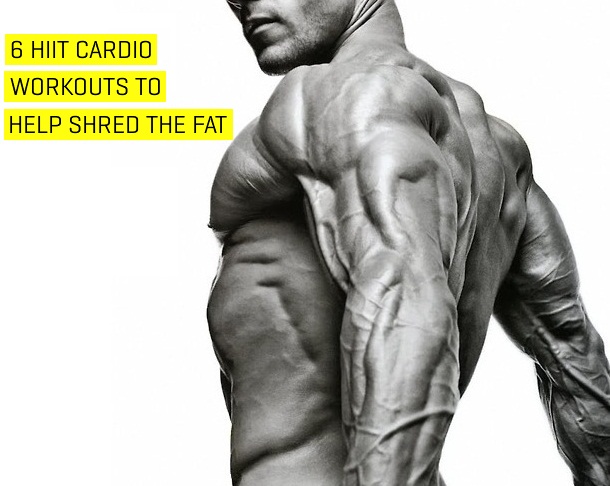
The Energy Systems
Before we pop the bottles of champagne, I want to educate you on some of the energy systems that are going to be used during these workouts. There are three energy systems that you will use.
#1 High Energy Phosphate System
The first being the high energy phosphate system which provides energy for muscles in the initial 1 to 15 seconds of high intensity activity (1). ATP (quick burst of energy) will be activated during this system, which is great because that’s what causes the body to make metabolic changes.
#2 Anaerobic Glycolytic System
The second being the Anaerobic Glycolytic System which the body relies primarily on anaerobic metabolism for the energy required to perform intensive exercise of greater than 12-15 seconds and less than 3 minutes duration (2). This system will be another way to overload your muscles, as you will be firing those muscle fibers so fast, you are going to recruit the fast twitch fibers and evidently you’re going to cause muscle damage (a good thing).
#3 Aerobic Oxidative System
The third system being the Aerobic Oxidative System which consists primarily of exercises that are performed at an intensity lower than that of the anaerobic threshold (3). Meaning that you will not get any lactic acid (burning sensation) production when you’re in this system and it will be mainly a brisk to fast pace walk or light jogs to keep your heart rate elevated.
So as you can see with all three of the energy systems above, they will all be used in these 6 workouts. Alright, enough with all this science mumbo jumbo, let’s HIIT it!

#1 Car Pushes
Yes you heard me… Car pushes! If you have never tried car pushes then you are missing out on one of the best HIIT cardio workouts around. This is one of the best ways to improve cardio conditioning, leg drive and power, some upper body pressing power and build a great physique. I’ve found that my squats and leg pressing power have improved since doing these because of the overload the car puts on your legs and you have to use a tremendous amount of lower body strength, as well as upper body strength to move the car. Car pushing is very underrated for strength training and power in my opinion. The cool thing about car pushing is that there are literally hundreds of yards of empty space around somewhere near you, so all you have to do is put it in neutral, drop your head down, arms straight, get low and push with all you’ve got for 10-30 seconds.
Now depending on if you’re a newbie or advanced trainee, choose the car you push wisely. If you weigh 100 pounds you probably don’t want to push a Hummer. If you’re 200 plus, you probably don’t want to push a slug bug. You get the point!
The Protocol
- 10 minute brisk walk or slow paced jog for warm up
- 4 intervals of 10-30 second all out pushes and 3-4 minute brisk walk in between intervals
- 10 minute brisk walk to cool down
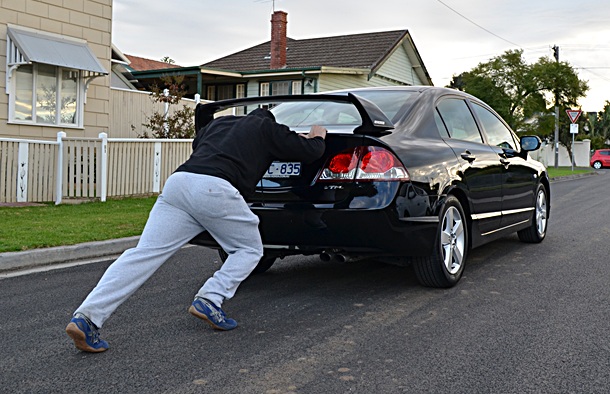
#2 Sled Drags
I’m sure some of you are saying what the hell are sled drags? Sled drags are very effective for the athlete, power lifter, or down-right bad ass that wants to get in tip top shape. Dragging a weighted sled by using a harness tied to your waist allows you to activate the core to work harder as well as your glutes and hams. The harness also forces you to keep a straight, stiff spine throughout the exercise, regardless of how tired you get. Rounding the back at anytime will immediately look and feel very awkward, giving instant feedback to straighten out or stop and rest. The great thing about sled dragging is it can have a carryover effect to many things, such as: Football, athletes learning how to explode when moving. Powerlifting, sled dragging strengthens your posterior chain and that can help with deadlifting. Track and field, overloading your waist and sprinting with weights can lead to more explosive movements when you train without them. If you aren’t sled dragging, then you are missing out on superior strength gains and conditioning.
If you decide to sled drag, a good rule of thumb is “you’ve got too much weight when you’re walking like you’re drunk.”-Louie Simmons
The Protocol
- 10 minute brisk walk or slow paced jog for warm up
- 5 intervals of 10-30 seconds all out sled dragging and 2-3 minute brisk walk in between intervals
- 10 minutes brisk walk to cool down
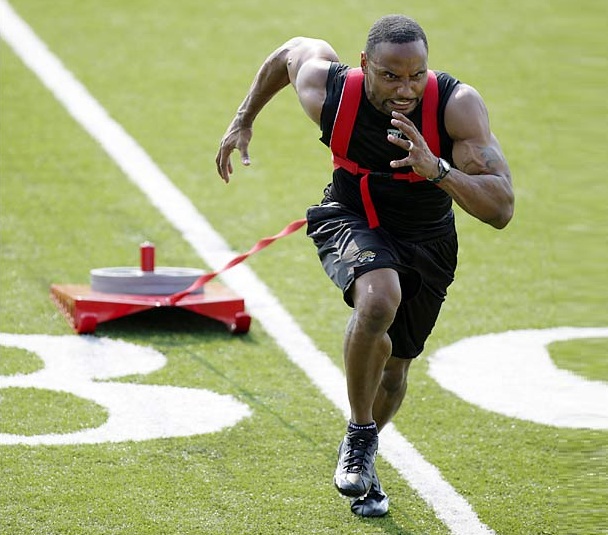
#3 Heavy Rope Training
Heavy rope training was originally developed for specific combat sports such as Football and Mixed Martial Arts; it is now becoming very popular for conditioning work and HIIT cardio. If you’re looking for a new twist to your fitness routine or if you’re one of those that complain about other HIIT cardio workouts being too demanding on your legs the day after a leg session, then this is what you’re looking for. Along with increasing your strength, power, and endurance, the constant motion of rope battling will give you a hell of a workout. Some common movements include waves, slams, throws, spirals, and whips. These all involve swinging your arms up and down (or side to side) for timed intervals. With each of these exercises, you want to create a solid base by planting your feet in a shoulder width stance and stabilizing your core, think of an athletic stance.
You’ll quickly discover that these exercises engage not just your arms and shoulders, but your whole body.
The Protocol
- 5 minute moderate jump rope for warm up
- 3-5 sets of 10-30 second intervals (waves, slams, throws, spirals, whips) and 45-60 seconds of rest in between intervals
- 5 minutes of moderate jump rope to cool down
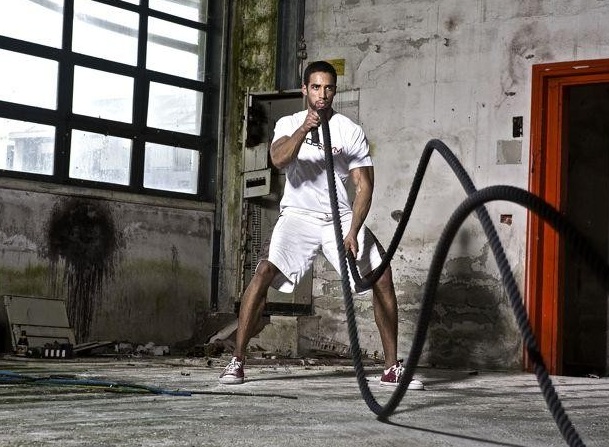
#4 Kettlebell Swings
Believe it or not but kettlebells are starting to be increasingly popular. Specifically kettlebell swings have become a great HIIT cardio workout to activate your glutes and hamstrings. A study in the Journal of Strength and Conditioning found as the movement progressed from the bottom of the swing to the top of the swing, back muscle activation peaked first at around 50% of MVC (maximal voluntary contraction), followed by abdominal/oblique activation at around 20-30% of MVC, followed by gluteal muscle activation at around 75% of MVC (4). As you can see kettlebell swings stimulate your glutes, strengthen your back muscles, engage your core muscles and help strengthen the hip and knees. Muscle activation ramps up during a half-second interval in the concentric phase (top of the swing) and then transitions to almost complete relaxation during much of the eccentric phase (coming down with the swing) (5). So every time you are swinging that kettlebell you are firing muscle fibers and this could lead to overall muscle growth. If you’ve never tried kettlebells for HIIT then your booty and hamies are in for a long day!
Make sure to be wise when you choose the weight, you aren’t going for a 1 rep max, pick a comfortable weight that you can swing and use good form to really activate all the muscles.
The Protocol
- 5 minute moderate jump rope for warm up or 10 minute brisk walk/jog
- 5 sets of 10-30 second intervals (all out swings) and 45-60 seconds of rest in between intervals
- 5 minutes of moderate jump rope or 10 minute brisk walk/jog to cool down
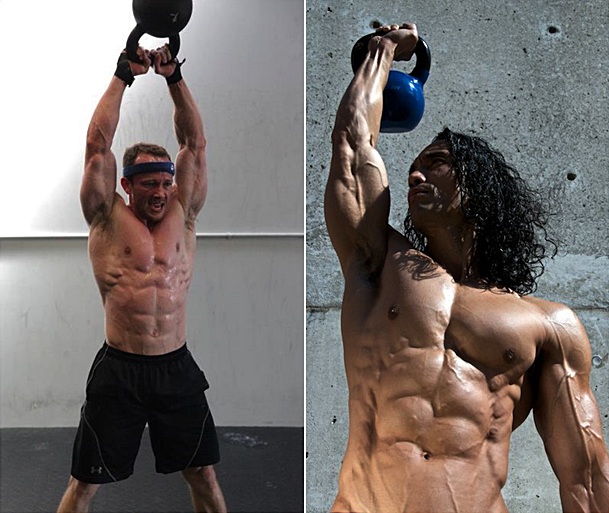
#5 Boxing
Here’s a HIIT workout you can do after your boss was on your ass all day or if you have one of those days when you feel a big weight on your shoulders…Hit the heavy bag! Hitting a punching bag is a great upper body workout and tailors well for those that have lower body injuries or limitations. One recommendation I will make is to not do a heavy upper body workout following this workout or the day after. Make sure to have an off day or lower body day. Your shoulders and arms will feel like you got in a bar fight with Mike Tyson after this workout.
The Protocol
- 10 minutes of jump rope for a warm up
- 5 rounds of 10-30 second all out (everything you’ve got beating the crap out of that bag)
- 2-4 minutes of jump roping in between rounds
- 10 minute brisk walk to cool down
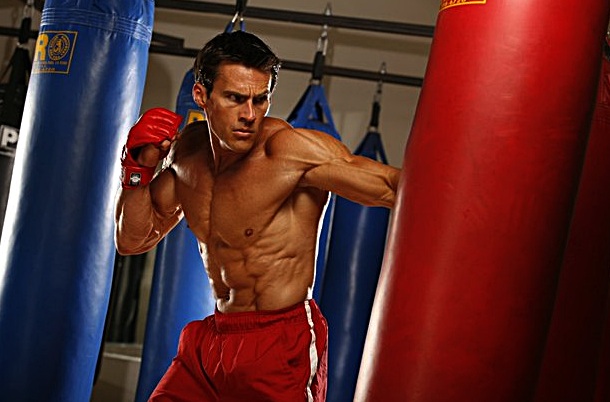
Julien Greaux – Alex Ardenti Photography
#6 Sprints
Last but not least how can I leave out good old sprints that have been tried and true for the longest time. Just look at sprinters legs compared to a long distance runners legs. Obviously the sprinter has more muscle mass on their legs because they’re activating fast twitch muscle fibers and creating muscle damage which leads to muscle growth. If you don’t believe me, go do sprints and you’ll see how sore you are the next day, it’ll feel almost the same as if you did an intense leg workout and that’s because you activated and broke down those muscle fibers. A recent study by Metcalfe et al. shows if you perform what Metcalfe and colleagues call the “minimal amount of exercise for improving metabolic health” a 3x per week 10min exercise regimen with no more than two (yes, I said it only 2 times!) all-out sprints, everything you’ve got, you will make changes to your metabolic rate (6). This 6 week exercise program was compared to the results of a 10 month intervention program in subjects who exercised 3x a week for 40min (steady state).
Metcalfe’s study goes to show that it’s a more efficient way to burn fat by doing 3x per week for 10 min with only 2 all out sprint intervals because the steady state endurance study was not only four times more time-consuming, but it also failed to improve the glucose tolerance test and produced no improvements in insulin sensitivity.
The Protocol
- 10 minute brisk walk
- 5 sets of 10-30 second intervals (all out, everything you’ve got) and 1-4 minutes of rest in between intervals
- 10 minute brisk walk to cool down

Wrapping it up
Now don’t get all bent out of shape after this, but you must understand the pros and cons of doing HIIT cardio workouts. They should be used as a tool and not be overused. I wouldn’t recommend more than 3-4 HIIT cardio workouts a week and I would definitely not do them after a high intensity leg workout day. Also, you’re probably wondering why I keep saying 10-30 seconds of intervals and that’s because everyone’s AT (anaerobic threshold) is different. You have to build your tolerance and get conditioned for these types of workouts and the more you do it and push yourselves, the more your AT will improve. With that in mind, we are all different and respond differently to certain things. So experiment yourself and see what you like best and what works best for you. Start with 10 second intervals and see if you can eventually get to 30 seconds.
Just don’t overdo it or take that risk of injuring yourself. Now that you have these 6 workouts in your gym bag of tricks… go HIIT it!
Author: Chris Martinez
References:
(1) Hultman E, Bergstrom J, Anderson NM. Breakdown and resynthesis of phosphorylcreatine and adenosine triphosphate in connection with muscular work in man. Scand J Clin lab Invest. 1967.
(2) Wilmore JH, Costill DL (eds). Physiology of sport and exercise 3rd edition. : Human Kinetics
(3) Wells GD, Selvadurai H, Tein I. Bioenergetic provision of energy for muscular activity. Paediatric Respitory reviews. 2009.
(4) McGill, SM. Marshall, LW. Kettlebell swing, snatch, and bottoms-up carry: back and hip muscle activation, motion, and low back loads. J strength Cond Res. 2012. Jan 26
(5) Contreras, Brett
(6) Metcalfe et al. Towards the minimal amount of exercise for improving metabolic health: beneficial effects of reduced-exertion high-intensity interval training. European J applied Physio. 2011.










